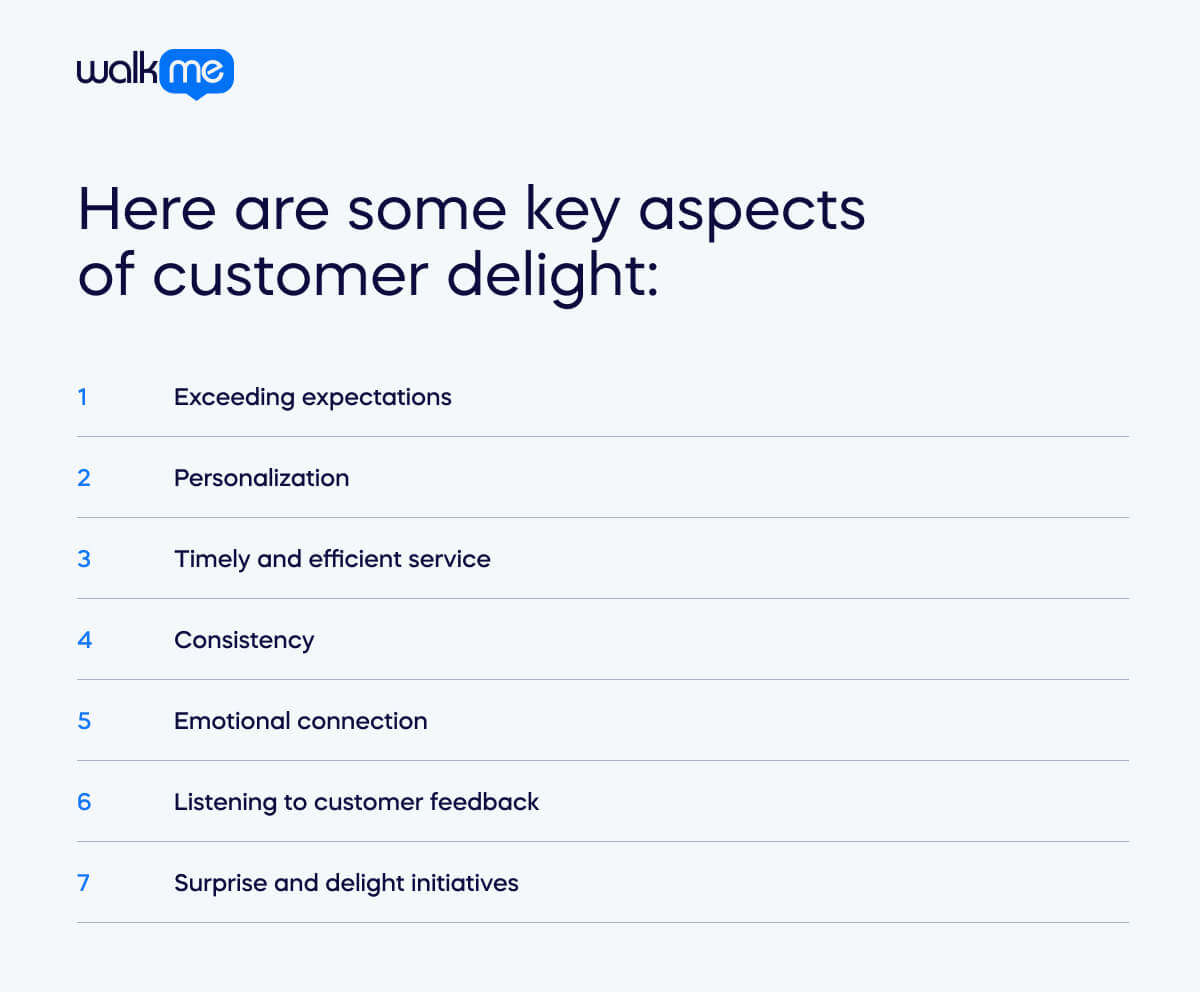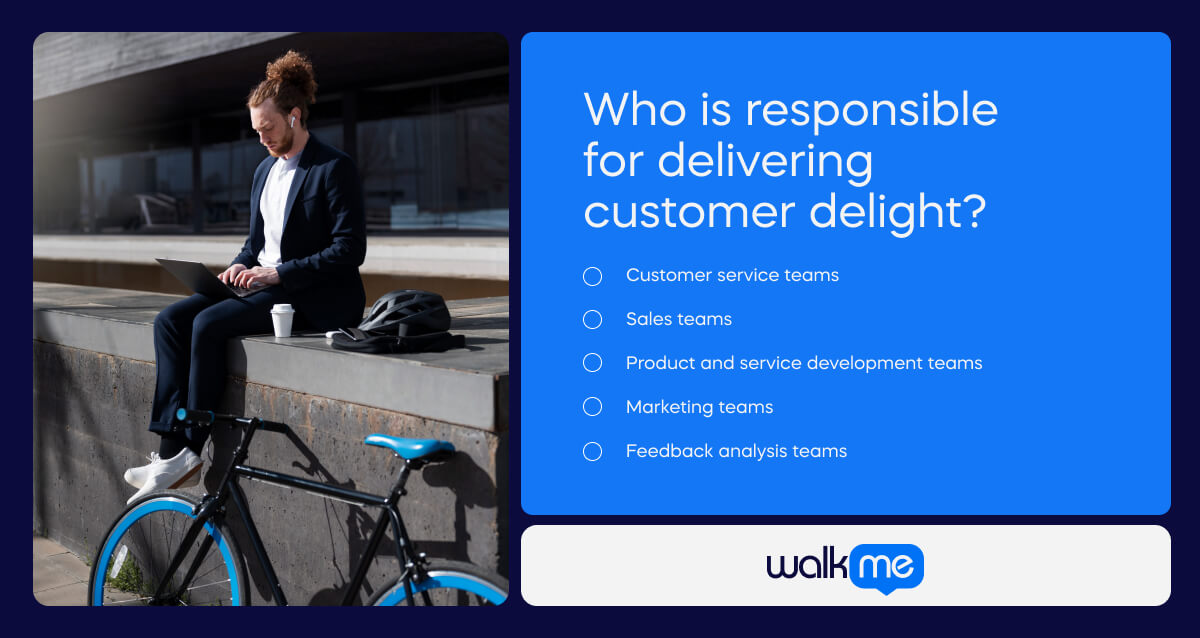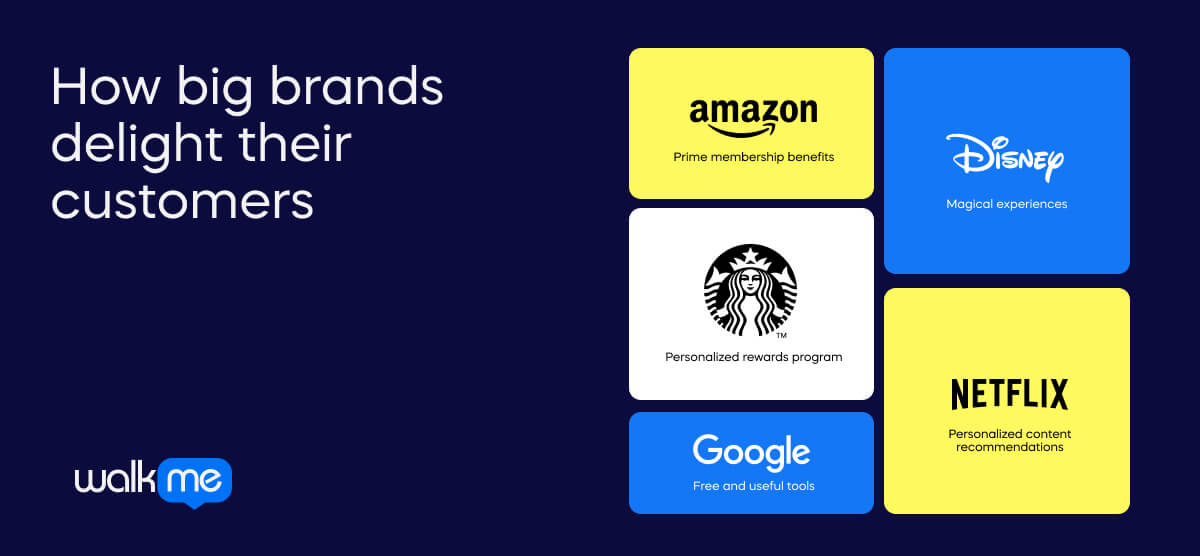What is customer delight?
Customer delight refers to exceeding customer expectations by providing a positive and memorable experience that goes beyond merely satisfying their needs.

Table of contents
According to a report by McKinsey, companies that deliver excellent customer journeys increase employee satisfaction and engagement by 30%.
It goes a step further than customer satisfaction. Delighting customers involves creating moments of surprise, joy, and satisfaction that leave a lasting impression and build strong customer loyalty.
Customer delight is an important concept in the field of customer relationship management (CRM) and is often seen as a key driver for customer retention and brand loyalty.
Satisfied customers are more likely to become repeat customers, recommend the brand to others, and contribute to the business’s overall success.
Here are some key aspects of customer delight:

Exceeding expectations
Delighting customers often involves going above and beyond what they expect. This could be in terms of product quality, service delivery, or any other aspect of the customer experience.
Personalization
Understanding individual customer needs and preferences allows businesses to tailor their products or services to specific customers. Personalized experiences make customers feel valued and appreciated.
Timely and efficient service
Providing prompt and efficient service is crucial for customer delight. Resolving issues quickly, responding to inquiries promptly, and delivering products on time contribute to a positive customer experience.
Consistency
Consistency in delivering a high level of service across all customer touchpoints is essential. Customers should have a consistently positive experience whether they interact with a company online, in-store, or through other channels.
Emotional connection
Building an emotional connection with customers can lead to long-term loyalty. When customers feel a connection with a brand, they are more likely to become repeat customers and advocates.
Listening to customer feedback
Actively seeking and listening to customer feedback allows businesses to understand customer needs and preferences better. This information can be used to improve products and services continuously.
Surprise and delight initiatives
Implementing surprise and delight initiatives, such as unexpected discounts, exclusive offers, or personalized gifts, can create memorable experiences for customers.
Who is responsible for delivering customer delight?

Delivering customer delight is a collective responsibility that involves various departments and individuals within a business.
While there might not be a single person solely responsible for customer delight, several key roles contribute to creating a positive and memorable customer experience:
Customer service teams
Customer service representatives play a crucial role in addressing customer inquiries, resolving issues, and ensuring a positive interaction. Their responsiveness and helpfulness contribute significantly to customer satisfaction.
Sales teams
Sales professionals are often the initial point of contact with customers. By understanding customer needs and preferences, they can tailor their approach and offerings to create a positive impression.
Product and service development teams
The teams responsible for developing products or services need to focus on meeting or exceeding customer expectations. Understanding customer needs and incorporating feedback into product or service improvements is essential for long-term success.
Marketing teams
Marketing plays a role in shaping customer perceptions and expectations. Clear and accurate communication about products or services can help set realistic expectations, preventing disappointment and contributing to positive experiences.
Feedback analysis teams
Teams responsible for collecting and analyzing customer feedback are essential for understanding customer sentiments, identifying pain points, and implementing improvements.
The purpose of customer delight
The purpose of customer delight is to go beyond merely satisfying customers by providing them with exceptional service or product experiences that exceed their expectations.
This concept is vital in today’s competitive business environment for several reasons:
Customer loyalty
Delighting customers builds a strong emotional connection with the brand. Loyal customers are more likely to continue doing business with a company, make repeat purchases, and become advocates who recommend the brand to others.
Repeat business
Satisfied customers are more likely to become repeat customers. By consistently exceeding customer expectations, businesses can encourage customers to choose their products or services again and again.
Positive word-of-mouth
Delighted customers are likely to share their positive experiences with friends, family, and on social media. Positive word-of-mouth can significantly impact a company’s reputation and attract new customers.
Brand advocacy
Customers who are delighted with a brand are more likely to become advocates. They may actively promote the brand, participate in referral programs, and defend the brand against negative feedback.
Competitive advantage
Providing a delightful customer experience can be a key differentiator in competitive markets. Businesses that consistently delight customers set themselves apart from competitors, attracting and retaining a loyal customer base.
Reduced churn
Customer delight can contribute to a lower churn rate, as satisfied customers are less likely to switch to competitors. This is particularly important in industries with high competition and customer retention.
Increased customer lifetime value
Delighted customers tend to have a higher lifetime value as they continue to make purchases over an extended period. This contributes to the overall financial success of a business.
Enhanced brand image
Customer delight positively influences the perception of a brand. Brands that prioritize customer satisfaction and consistently deliver delightful experiences are likely to be seen as trustworthy, reliable, and customer-focused.
Reduced customer acquisition costs
Satisfied and delighted customers can become a source of new business through referrals. This can reduce the costs associated with acquiring new customers, as word-of-mouth referrals can be a highly effective and cost-efficient marketing channel.
Customer retention
Customer delight is a powerful tool for customer retention. It helps in retaining existing customers, reducing the need for businesses to constantly acquire new customers to maintain growth.
Adaptability to changing markets
Businesses that prioritize customer delight are often more adaptable to changing market conditions. By staying attuned to customer needs and preferences, companies can adjust their strategies to remain relevant and competitive.
Customer delight vs. customer satisfaction
| Customer delight | Customer satisfaction |
| Involves exceeding customer expectations, providing unexpected positive experiences, and creating an emotional connection. | Represents meeting customer expectations. A baseline measure of a good customer experience. |
| Goes beyond meeting functional needs and taps into the customer’s emotions, creating a positive and memorable experience that fosters loyalty and advocacy. | Satisfied customers are content, but their emotional attachment to the brand may not be as strong. |
| Surpassing their expectations. It’s about providing value and experiences beyond the customer’s anticipated, creating positive surprises. | Meeting or slightly exceeding customer expectations. Delivering on what was promised and meeting the customer’s basic needs. |
| Delighted customers are more likely to be loyal, repeat customers, and brand advocates. | Satisfied customers are likely to repeat business and may become loyal to a certain extent. |
| May involve more qualitative assessments, as it’s about understanding the emotional impact of the customer experience. This could include assessing customer feedback, loyalty metrics, and brand sentiment. | Often measured through surveys and feedback mechanisms that assess whether customers’ basic expectations were met. |
How to measure customer delight
Measuring customer delight can be challenging because it involves capturing the emotional aspect of the customer experience.
Unlike customer satisfaction, which can be assessed through more straightforward surveys and metrics, delight often requires a more nuanced approach.
Here are some methods and strategies for measuring customer delight:
Customer feedback surveys
Use surveys to gather feedback on the overall customer experience. Include open-ended questions that encourage customers to share their feelings and emotions about their interactions with your brand.
Net promoter score (NPS)
While NPS is traditionally associated with measuring customer loyalty, it can also provide insights into customer delight. Promoters are not just satisfied; they are delighted with the experience. Monitoring changes in NPS over time can indicate shifts in customer delight.
Customer reviews and testimonials
Monitor online reviews, testimonials, and social media mentions. Positive and enthusiastic customer reviews often indicate delight. Analyzing the language used by customers can provide insights into the emotional impact of the experience.
Customer interviews and focus groups
Conduct one-on-one interviews or focus groups with customers to delve deeper into their experiences. These qualitative methods allow customers to express their emotions and provide detailed feedback beyond what can be captured in surveys.
Customer journey mapping
Map the customer journey to identify touchpoints where delight can be created. Assess customer emotions at each stage and identify opportunities to exceed expectations.
Repeat business and loyalty metrics
Track metrics related to customer retention, repeat business, and loyalty programs. Delighted customers are more likely to become repeat customers and brand advocates.
Employee feedback
Employees who directly interact with customers can provide valuable insights into customer emotions. Regularly gather employee feedback from frontline staff to understand customer sentiments and identify areas for improvement.
Social media monitoring
Monitor social media channels for mentions of your brand. Positive and enthusiastic posts, likes, and shares can be indicative of customer delight. Engaging with customers on social media can also provide opportunities to create delightful moments.
Customer complaints and issue resolution
Analyze how customer complaints and issues are handled. Turning a negative experience into a positive one can contribute to customer delight. Measure the effectiveness of your resolution process.
Surprise and delight initiatives
Implement surprise and delight initiatives, such as unexpected gifts, personalized offers, or exclusive access to events. Monitor the impact of these initiatives on customer sentiment.
Benchmarking against competitors
Compare your customer satisfaction and loyalty metrics against industry benchmarks. If your metrics are significantly higher, it may indicate that you are delighting customers more effectively than your competitors.
How big brands delight their customers

Big brands often invest heavily in customer delight initiatives to build strong relationships, enhance brand loyalty, and create positive word-of-mouth. Here are examples of how some well-known companies delight their customers:
Amazon
Prime membership benefits
Amazon’s Prime membership offers perks such as fast and free shipping, exclusive access to deals, streaming services, and more. This subscription model meets customer expectations and exceeds them, creating a sense of value and loyalty.
Starbucks
Personalized rewards program
Starbucks’ loyalty program, Starbucks Rewards, offers personalized rewards, free drinks on birthdays, and special promotions. The mobile app also allows customers to order ahead and skip the line, enhancing convenience and creating a more enjoyable experience.
Disney
Magical experiences
Disney is known for creating magical experiences at its theme parks. From character interactions to immersive attractions, Disney goes the extra mile to exceed visitors’ expectations, creating lasting memories for families.
Netflix
Personalized content recommendations
Netflix uses algorithms to analyze user preferences and offer personalized content recommendations. This level of personalization enhances the user experience and keeps customers engaged with the platform.
Free and useful tools
Google provides a suite of free and user-friendly tools such as Gmail, Google Drive, and Google Maps. These tools meet users’ needs and often exceed expectations in terms of functionality and accessibility.
How to delight your customers
Here are several strategies that businesses can employ to consistently delight their customers:
Understand customer needs
Invest time and resources in understanding your customers’ needs, preferences, and pain points. This knowledge forms the foundation for creating products, services, and experiences that resonate with them.
Provide exceptional customer service
Offer prompt and helpful customer service. Train your staff to be knowledgeable, empathetic, and proactive in addressing customer inquiries and issues. A positive service experience can contribute significantly to customer delight.
Personalize customer interactions
Use customer data to personalize interactions. Address customers by their names, recommend products based on their purchase history and tailor your communication to their preferences. Personalization creates a sense of being valued.
Surprise and delight initiatives
Implement unexpected gestures, such as sending personalized thank-you notes, offering exclusive discounts, or providing freebies. Surprise and delight initiatives create positive emotional responses and leave a lasting impression.
Create seamless experiences
Streamline the customer journey to make it as smooth and effortless as possible. Remove friction points, simplify processes, and ensure seamless transitions between different touchpoints.
Go above and beyond
Exceed customer expectations by going the extra mile. Whether it’s providing additional assistance, offering extended warranties, or delivering faster than promised, these efforts can create moments of delight.
Solicit and act on feedback
Encourage customers to provide feedback and actively use that feedback to make improvements. This not only shows that you value their opinions but also demonstrates a commitment to continuous enhancement.
Reward loyalty
Implement a loyalty program that rewards customers for repeat business. Offer discounts, exclusive access, or other perks to show appreciation for their loyalty.
Transparent communication
Communicate transparently about your products, services, and any changes that may affect customers. Honest and clear communication builds trust and contributes to a positive customer experience.
Innovate and stay relevant
Regularly assess market trends and customer preferences. Innovate your products, services, and processes to stay relevant and provide customers with cutting-edge solutions.
Create a positive company culture
Foster a company culture that prioritizes customer satisfaction. When employees are aligned with customer-centric values, they are more likely to contribute to creating positive experiences for customers.
Anticipate customer needs
Proactively anticipate customer needs and address them before customers have to ask. This can involve predictive analytics, anticipating common issues, and offering solutions in advance.
Empower frontline employees
Empower your frontline employees to make decisions that prioritize customer satisfaction. When employees have the authority to resolve issues and create delightful moments, it enhances the overall customer experience.
Use technology wisely
Leverage technology to enhance the customer experience. This could include user-friendly websites, mobile apps, chatbots for quick support, and other digital tools that make interactions convenient and enjoyable.
Educate and add value
Provide educational content, resources, or workshops that add value to your customers’ lives. Helping them solve problems or improve their skills demonstrates a commitment to their well-being.